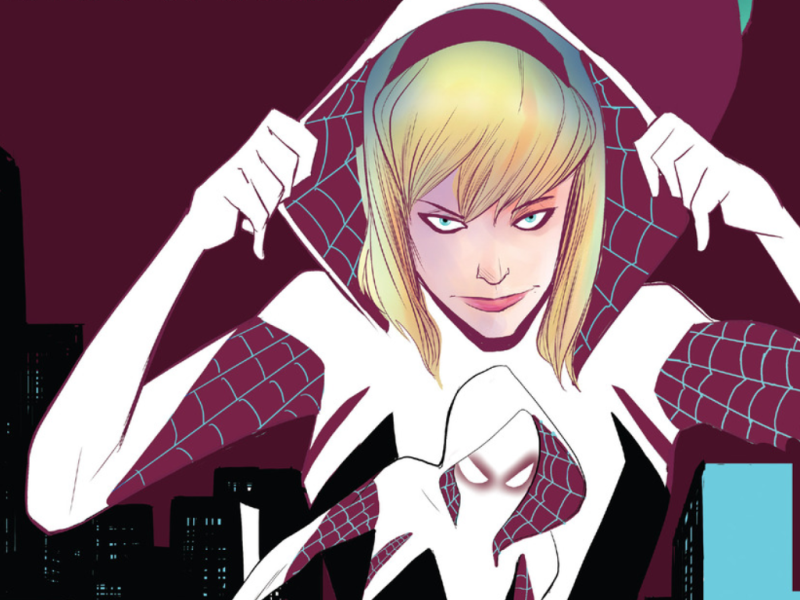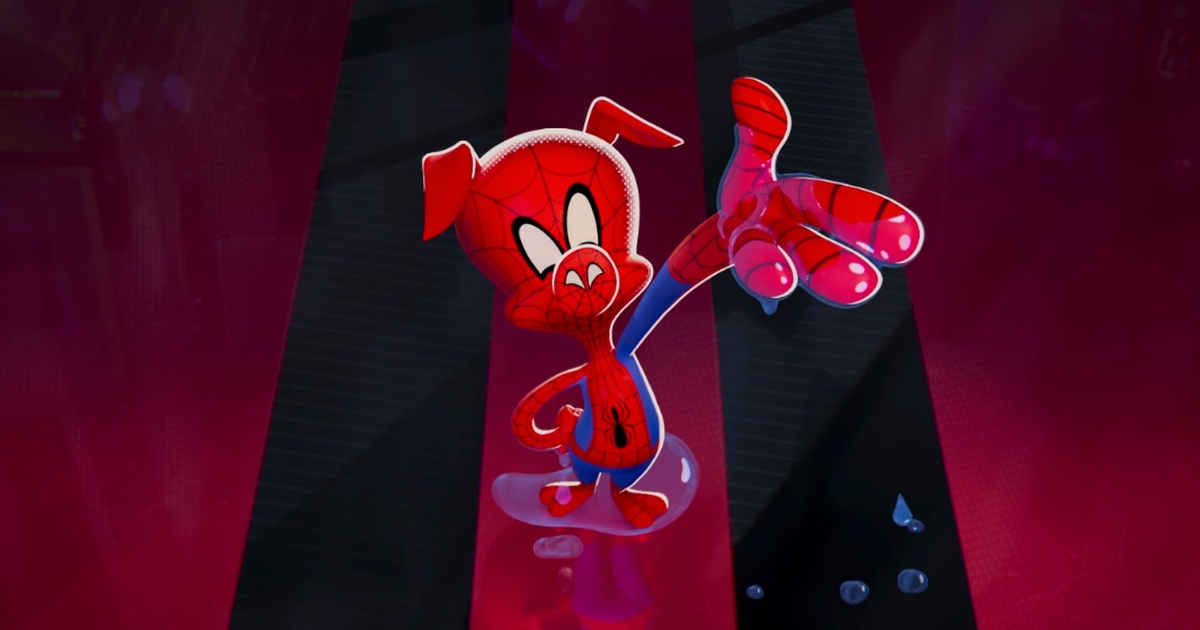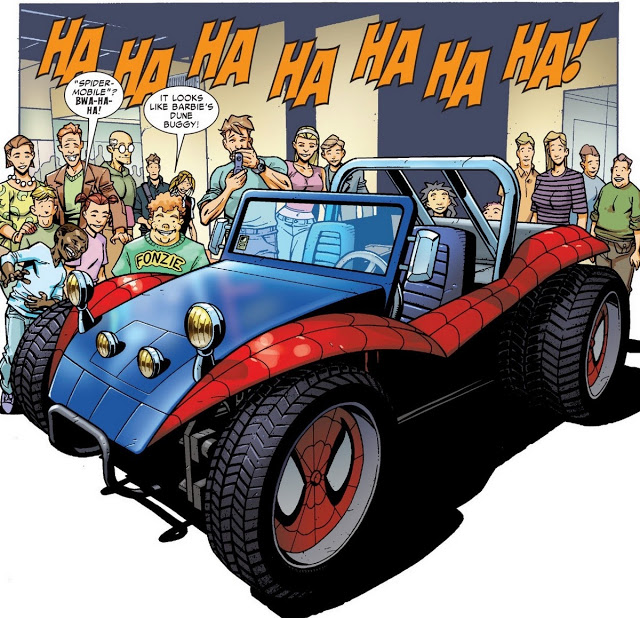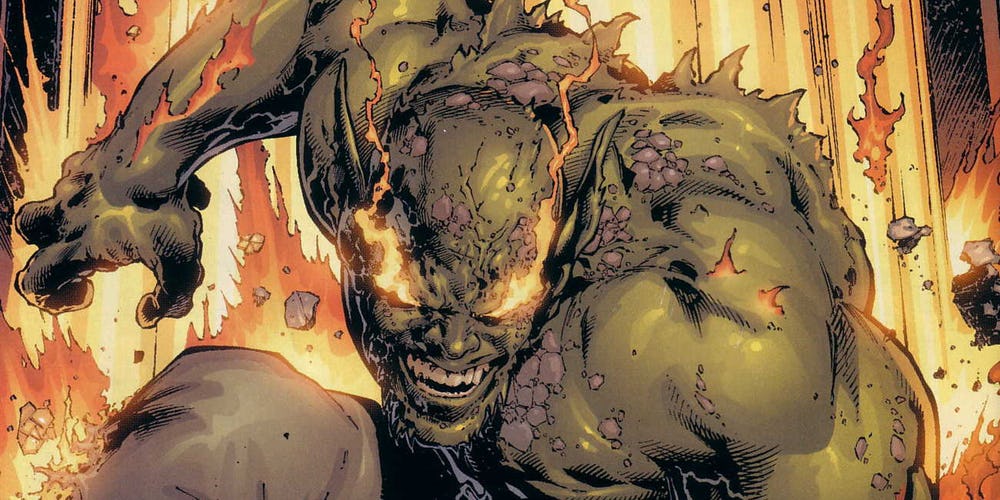Spider-Man: Into the Spider-Verse Marvel Easter Eggs and References
We're tracking down every Marvel Universe Easter egg and reference in Spider-Man: Into the Spider-Verse. Help us out!
This article consists of nothing but Spider-Man: Into the Spider-Verse spoilers.
Well, Spider-Man: Into the Spider-Verse absolutely delivers everything a Spider-Man fan could possibly want. Who needs the Marvel Cinematic Universe when you’ve got a movie that tells such a wonderful, compelling story on its own, and one that draws so heavily, and so purely, from Spider-Man mythology, right?
For those of you who want to dig as deep as you can on everything Spider-Man: Into the Spider-Verse has to offer, we give you this (mostly) complete guide to Easter eggs in the movie. If you spot something we missed, mention it in the comments, or give Mike or Gavin a shout on Twitter… and if it checks out, we’ll update this and credit you!
Now, let’s get swingin’…
Spider-Man: Into the Spider-Verse Characters
While the multiverse is, of course, infinite, this movie focuses on a handful of key Spider-people.
Miles Morales
Miles Morales was created by Brian Michael Bendis and Sara Pichelli. He originally appeared in Marvel’s (now defunct) Ultimate universe, as the replacement for a very dead Peter Parker. Sound familiar? He’s currently part of the main Marvel Universe though.
– The genetically modified spider that gives Miles Morales his powers has the #42 on it, this is straight out of his Ultimate Spider-Man comics origin, as is the stuff about Miles getting into the private school due to winning a lottery.
But as Jeremiah reminded us down in the comments, #42 was worn by Jackie Robinson, the first black man to play in Major League Baseball. And the team he played for? That would be the Brooklyn Dodgers. While Miles (AND his dad) are both too young to remember a time when the Dodgers played in Brooklyn, Miles is a Brooklyn boy (as opposed to Peter’s Queens background), so this is significant, and probably not accidental. And if you need any additional Marvel connections, Chadwick Boseman (Black Panther himself) played Robinson in the film, 42. The movie is OK, but if you really want to learn more about Jackie Robinson (and you should), there’s a Ken Burns documentary about him.
– Miles is often seen reading a comic called True Life Tales of Spider-Man. The name and the logo recall an actual Marvel series called Untold Tales of Spider-Man, which came out during the 1990s and told stories that happened “in between” important moments in Spidey’s early career. One of the covers is an obvious callback to Amazing Fantasy #15, the first appearance of Peter Parker.
– Names in Miles’ phone include B. Bendis and Sara Pichelli. He’d better have those names in there… they are the people who created him! The pair get another shout out later on, as when Miles accepts who he is, the comic book cover mentions Bendis/Pichelli.
Meanwhile, Miles’ Dad’s phone has Peter Parker co-creator Steve Ditko on speed dial. Of course Steve Ditko wasn’t really fond of taking phone calls, but it’s great to see him referenced here (and, also of course, Stan Lee has his traditional, and first posthumous, cameo).
– Miles wonders how two Spider-Men could exist and for a second we see a comic cover of “Two Spider-Men.” Spider-Men is the first crossover between 616 Peter and Miles.
Peter Parker
– This movie takes place about 10 years into this world’s version of Spider-Man’s career. To fill in the blanks, there are loads of visual homages to the three Sam Raimi Spider-Man movies during the scenes establishing who this world’s Spider-Man is, including the restaurant/taxi/spider-sense sequence, the famous bit where Spidey stops the subway on the elevated tracks, the upside-down kiss (initially reversed here with MJ being the one upside down), the horrid dancing from Spider-Man 3, and more. Later in the movie, Spidey’s “broke my back” joke is both another Spider-Man 2 reference and a callback to Tobey Maguire’s back problems/negotiating tactics between the first two movies. There’s also a visual homage to him pulling the Staten Island Ferry together from Spider-Man: Homecoming.
– Peter Parker and Mary Jane are divorced in the older Peter’s world. This is rather surprising to see if you were following the character back in the mid-00s. Joe Quesada really did not like the idea of the two being married because he felt it made Peter too hard to relate to. He had to go through the stunt of having them sell their marriage to Mephisto (the Devil…but from space!) to create a retcon that they never got hitched. Why not just have them straight-up get divorced? Quesada claimed it would age Peter too much and would make him even harder to relate to. Meanwhile this movie makes a 40-year old Peter Parker going through a midlife crisis as easy to relate to as any version of the character in history, but whatever.
– Peter burying Aunt May might also be viewed as a reference to when Aunt May originally died in The Amazing Spider-Man #400 in 1995. It was a beautiful story where Aunt May revealed she’s known Peter was Spider-Man for years. That too got undercut by horrible comic book writing to “de-age” the character. It was revealed the May who died was really an actress hired by the Green Goblin to play mind games while the real May was sedated in… you know what, don’t ask.

Spider-Man Noir
– Spider-Man Noir comes from a brief line when Marvel released miniseries that reimagined their characters as grounded 1930s-1940s counterparts. For instance, X-Men Noir was about a group of grifters with special gifts (ie. Rogue’s ability to perfectly steal someone’s identity) opposing a corrupt police force. Spider-Man Noir received two miniseries and appeared to be the only hero of that line to have actual powers. His origin is rather ill-explained, where he’s bitten by what appears to be mystical spiders and hallucinates seeing a spider god.

Spider-Gwen
– Spider-Gwen made her first appearance in Edge of Spider-Verse #2, created by Jason Latour and Robbi Rodriguez. There are a lot of differences in her reality, but one of them is that Gwen Stacy was the victim of the radioactive spider bite instead of Peter Parker. The gist of her quick backstory from the movie very much lines up with the comics. This includes the fact that her boyfriend Peter turned himself into the Lizard after being broken down from constant bullying. Spider-Gwen fought the Lizard a little too hard with the offense and ended up killing him by accident.
She also plays in the Mary Janes, a band also made up of Mary Jane Watson, Betty Brant, and Glory Grant.
She’ll return in an animated spinoff of her own, so don’t you worry.

Spider-Ham
Peter Porker, the Spectacular Spider-Ham (typing that will never, ever get old) first appeared in a one-shot comic in 1983 called (seriously) Marvel Tails, and then went on to headline his own book. He is exactly what you expect.
For more on Peter Porker, the Spectacular Spider-Ham, well…we have his complete and weird (and completely weird) history right here for you.

Peni Parker
Peni Parker and Sp//dr first appeared in Edge of Spider-Verse #5, and they were created by Jake Wyatt and My Chemical Romance’s own Gerard Way.
Believe it or not, this is only a small sampling of the Spider-Men of the Spider-Verse out there.
Spider-Man: Into the Spider-Verse Comics Easter Eggs
– Throughout the movie, there are loads of great references to printed comic book storytelling, like using the captions as thought balloons, Ben-day dots for effect, sound effects on screen, and more.
– On a monitor when Kingpin’s scientists were turning on the particle collider during the Spider-Man vs. Green Goblin fight, there are different Earth numbers mentioned like “E-616” and “E-1610.” 616 was the designation for the “main” Marvel Comics Universe, and 1610 for the Ultimate Universe. Following Secret Wars, the numbering scheme for the multiverse was reset.
– Is it us, or does Mary Jane in this movie look like J. Scott Campbell art?
– The shot of Uncle Ben “dying” looks an awful lot like one of the covers of Ultimate Spider-Man: Death of Spider-Man where we see Peter and Ben walking into the afterlife together.
– The pink-haired girl from Miles’ old school might be a reference to the Ultimate Comics version of Kate Bishop, who dated Miles for a bit.
– The revelation that this Spidey is blond feels like a slight nod to the Ben Reilly era of the character. Essentially (hoo-boy) in the ‘90s Marvel had this awful idea called The Clone Saga. In it, Peter Parker retires as Spider-Man and is replaced by his clone, who, to distinguish himself from Peter, dyes his hair and takes the name Ben Reilly (Ben after his Uncle, and Reilly being Aunt May’s maiden name).
– Peter plans to take Miles under his wing, but dies. In an issue of Ultimate Spider-Man, Miles and his friends discuss how things probably would have worked out if Peter survived. Miles admits that although he never got to meet his universe’s Peter Parker, he feels that Peter would have been his mentor.
Spidey’s Secret Headquarters
– In Spider-Men, 616 Peter does visit Ultimate Aunt May’s home. Although things work out in the end, her initial reaction is to attack him until Miles (who she knows) explains that he’s the real deal. Bonus! Aunt May appears to have her furniture covered in plastic. That’s a nice detail for anyone who has an elderly relative living in the boroughs of NYC. It’s basically standard issue.
– Pretty sure you can spot “The Rose” on the wall with the chart of the Fisk family in Spidey’s hideout.

– The infamous Spider-Mobile is on display in the late-Spider-Man’s lair. The Spider-Mobile was always a merchandise-driven creation, the irony being that Peter Parker didn’t actually know how to drive. Why? Well, for starters, he lives in New York City. If you grow up here, there’s little reason for you to drive. More importantly, he got his powers at 15 or 16, and the driving age in New York is 16. Why bother learning to drive when you can web swing?
– Suits in the lair include the video game costume, Iron Spider suit, stealth suit, MCU suit. The caped one is from What If v.1 #19 (he stopped the thief and remained an entertainer). One of them is Spider-Man from Exiles, coming from a world where Peter Parker wore the Carnage symbiote. Another is Peter’s “Stealth Suit” from the bizarre “Big Time” era in recent comics (whwere Peter was basically turned into Tony Stark/Bruce Wayne). It is the one with a big green emblem on an overall black attire. One would think the neon green undercuts the idea of stealth, but whatever. Also the way the costumes are aligned under glass feels intentionally evocative of the way Bruce Wayne displayed his and all of his sidekick’s old costumes in Batman Beyond.
Spider-Man: Into the Spider-Verse Villains
Now, let’s talk baddies…
The Prowler
– There have been several characters to assume the identity of the Prowler. The character has been kicking around the Marvel Universe since 1969 (as Hobie Brown), before a guy named Rick Lawson took over the role. But neither of those are the guy on screen here…
It was the Ultimate Universe Prowler who was Aaron Davis, Miles Morales’ uncle, and he didn’t come around until Ultimate Comics: Spider-Man #1 in 2011.
Kingpin
It’s kind of amazing that this is Wilson Fisk’s first appearance in a Spider-Man movie, especially given the popularity of the character both in the comics on TV. (He was previously portrayed by Michael Clarke Duncan in the 2003 Daredevil movie). Liev Schrieber manages to deliver a different enough performance from Vincent D’Onofrio’s to make it his own though.
-In the first scene with the supercollider, Fisk’s rationale for building it is “You can’t take it with you.” This is almost certainly a reference to Secret Wars – in issue #1, the formal death of the Ultimate Universe (where Miles is from), all the street level villains get an invite to the Bar with No Name offering a free drink to celebrate the end of everything. The email came from “wfisk@fiskindustries.com.” When the villains get there, they find that they’ve been trapped in the bar by the Punisher, who stands at the door and says “They say that when you die, you can’t take it with you. Which begs the queston: exactly what am I gonna do with all these bullets?”
– Kingpin is haunted by the rejection and deaths of his wife Vanessa and son Richard. In the comics (and especially the Daredevil Netflix series), Vanessa is a lot more open to Wilson’s dark dealings. In the main comics, Richard was an adult and hated his father, though never sure whether to usurp him as a villain or betray him as a hero. In the end, he was shot dead by Vanessa.
– The closest counterpart to the movie’s depiction of Richard Fisk is in Punisher MAX, where he was an 8-year-old boy. Wilson Fisk coldly allowed him to die in a hostage situation rather than give himself up to an enemy and Vanessa forever hated him for it.
– Kingpin has a flashback role in the comic Spider-Men II, where he inspires the story’s villain to enact a plot very similar to the movie. It’s revealed that Earth-616 did in fact have its own Miles Morales prior to the Ultimate Universe one showing up. This Miles was a longtime BFF of Wilson Fisk since their days in prison, but he wanted to leave his life behind and disappear with his wife Barbara. Fisk removed every trace of his identity and allowed him to move on. After Barbara’s death, Fisk comforted his old friend and told him about the concept of checking alternate realities for a living and single Barbara. Fisk admits to thinking of using that kind of technology to find another Vanessa.
– Kingpin’s bodyguard is Tombstone, otherwise known as Lonnie Thompson Lincoln. Created by Gerry Conway and Alex Saviuk back in 1988, Tombstone is an albino with the strength and fighting skill that makes him capable of trading blows with Spider-Man. He tends to exist as a mafia figure for the most part instead of a cackling supervillain and has indeed worked for Kingpin in the comics once or twice.
Doctor Octopus
– Dr. Olivia Octavius is an original character. Or as original as you can get for being a gender-flipped Otto Octavius. That’s kind of the point of the twist is. That said, there have been at least two female versions of Doc Ock in the comics. The most famous one is Carolyn Trainer, who took the mantle back during the Clone Saga days after Kaine snapped Otto’s neck. More recently, the Web-Warriors gained an ally in Octavia Otto, a member of the Young Avengers from a world where Spider-Man is the villain.
– Dr. Octavius talks up alternate universes and describes them as “WHAT IF to Infinity,” referencing Marvel’s famous alternate history comics as well as their most famous crossover events (and live action movies).

– The version of Green Goblin seen on the screen in this movie feels very much like the Ultimate version of the character, where Norman Osborn had actually mutated himself into a hulking green beast, rather than dressing like a goblin.
– This is a different version of Scorpion than we’ve seen in any movie, animated series, or game. Any ideas where he’s pulled from? In any case, this is Scorpion’s first shot at the big time on the big screen, although there’s an excellent chance he’ll appear in a future live action Spidey movie, as Mac Gargan was played by Michael Mando in Spider-Man: Homecoming.
– During the sequence showing off Spidey’s villains (most of whom make more substantial appearances in the movie), you can see a quick flash of Rhino at one point, but he doesn’t seem to appear anywhere else in the movie.
Spider-Man: Into the Spider-Verse Video Game References
– The shot of Peter Spider-Man crawling upside down towards the viewer looks exactly like the cover to the great PS1 game.
– Spidey does the “finger guns” like he does in the amazing PS4 video game.
Miscellaneous Spidey Stuff
– When Miles goes to his Uncle Aaron’s house, the episode of Community (“Anthropology 101”) with Donald Glover in a Spidey T-shirt is on TV. This visual was one of the main inspirations for Miles Morales’ very creation. Glover himself has voiced Miles on Ultimate Spider-Man: Web-Warriors and played the live-action version of Aaron Davis in Spider-Man: Homecoming.
– It’s not an Easter egg, but this movie has a terrific use of Black Sheep’s “The Choice is Yours,” a guaranteed party starter whenever it drops anywhere. Later in the movie there’s an appropriately cheesy use of “St. Elmo’s Fire.”
– Billboards in Times Square include: From Dusk til Shaun (the Shaun of the Dead sequel we deserve) and John Mulaney and Nick Kroll in “Hi, Hello.” Also a cartoon called Clone College (uh-oh…don’t say “clone” around Spider-Man fans) and a toy called Mr. Tomato Head.
Elsewhere in New York City you can spot signs that say “Bendis” (another nod to Brian Michael Bendis, Miles’ co-creator) and “Romita Ramen” (for John Romita Sr. and Jr…both of whom have made their mark on the Spidey mythos…but especially sr.)
– The shot of Peter sitting behind the desk, up to his shoulders, is from the ‘67 cartoon and lives on in meme form. This includes the infamous “And I’m just sitting here masturbating” memes, which was specifically referenced in a Web-Warriors comic when Spider-Gwen visited that cartoon’s world.
– Miles’ Spider-Man costume Halloween mask looks exactly like the old, cheap plastic Ben Cooper mask, right down to the nose holes.
– Did you know this movie almost featured a Doctor Strange cameo? Well…it almost did!
– I couldn’t tell for sure, but a piece of art in the underground area looked an awful lot like Leon: The Professional.
– Spider-Ham’s “That’s all folks!” is…well…you know where that’s from. Wait…is he even allowed to say that?
Spider-Man: Into the Spider-Verse Post-Credits Scenes
The initial end credits include at least two references to Spider-Man ‘67 stills that became popular. One is an image of Spider-Man sitting behind a desk while the wall behind him is covered in framed photos of himself. Another is the “hay” image, where Spider-Man was laying down on a train track. Despite the intent of the animated scenes, the way he’s posing makes it look more like a sexual invite. Earth-67 is where the 1967-1970 Spider-Man cartoon takes place. The footage originates from the season one episode “Double Identity.”
Spider-Man 2099
Spider-Man 2099 is Miguel O’Hara, an Alchemax employee from the future who accidentally gave himself spider powers. Taking up the mantle of Spider-Man, he was the first of many hero reprisals from that era. He has teamed up with his past counterpart on various occasions and has taken part in his share of dimensional team-ups.
Funny enough, the movie had set up Spider-Man 2099’s appearance way earlier, as Alchemax was introduced in the Spider-Man 2099 comics as a mega-corporation that does everything from pharmaceuticals to privatizing the police force. Only recently has Marvel created a modern-day take on the company, revealing it to be Liz Allen’s Allen Company after absorbing Oscorp and Horizon Labs.
We went into much more detail about those post-credits scenes right here.
